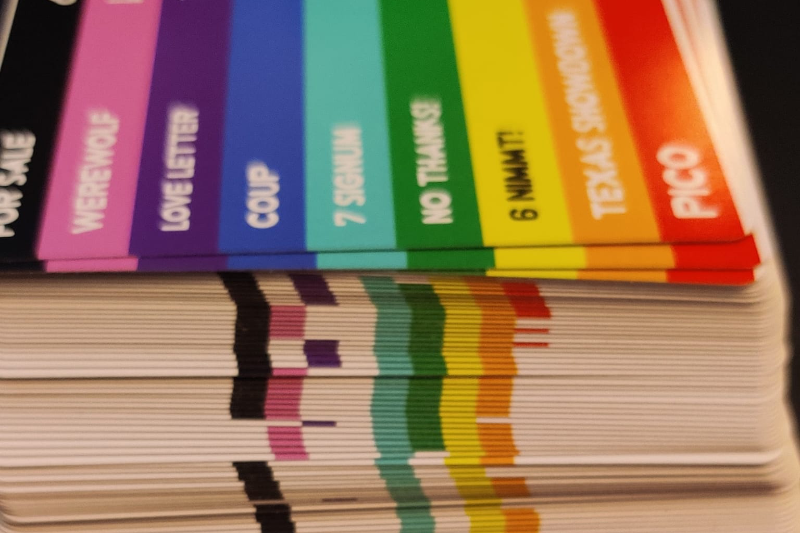Potluck #1: Research and Design

This is the first part in a three part blog series exploring my most recent tabletop design project, Potluck. The other parts, The Deck and My workflow, will publish on the first Wednesday of March and April respectively.
This part explores the background of the project and the research and design considerations that went into making it a reality. In the upcoming posts I'll go into the deck and its cards itself and what tools I used to build it.

What is Potluck?
Potluck is a semi-universal deck that fits into a pocket and plays dozens of different games.
Combining travel and board games is not the easiest puzzle in the world. Board games often come in large retail boxes and even with smaller boxes, carrying multiple of them in a backpack is not really feasible.
Potluck was born out of that problem in my life. I'm always on the move and meeting people around the world and wanted something that I can always carry with me and quickly bring to the table to play a game or two.
It builds on top of the three previous Minimal Travel Table Top Game Collections. The first Minimal Travel Table Top Game Collection one was my entry into this idea and combined a few existing games into double-sided cards. Minimal Travel Table Top Game Collection 2: Social Distancing Edition was a child of the pandemic and combined Print'n'Play published solo games into a similar deck than the first one. Minimal Travel Table Top Game Collection 3: Project 108 was my first attempt at building a semi-universal deck where each card can play multiple games and not just one.
This one, Minimal Travel Table Top Game Collection IV: Potluck is a direct sequel on the third one. It takes the same idea and mostly same design and improves it a lot.
I have mostly completed the design process but since I'm in the middle of moving countries, I haven't ordered the physical cards yet. I'll show some real cards in a later blog post once I get them.
The universality of playing cards
What does it mean for a deck of cards to be universal?
In my research, I found it's mostly used to describe a deck that implements one or more systems. The elements in a card don't match one to one with a specific game but rather builds a system that games can then use to implement different rules.
A basic example of universal system is the traditional playing cards - whether the French or Italian (or probably many others, these are the one's I'm familiar with). By using the French-suited one as an example, with cards ranging from 2 to 10 with J, Q, K and A in four suits (hearts, spades, clubs and diamonds), you can play nearly unlimited amount of games. Solitaire? Got it. Texas hold'em poker? Absolutely. Ristiseiska? Yup. The International Playing Card Society IPCS estimates there are roughly 1,000 to 10,000 games that can be played with that system.
Other people have taken this idea and added complexity in attempt to increase the amount and variety of games that can be played with one deck.
What originally got me interested in this hobby was The Everdeck that documented their design process very nicely.
The Everdeck is designed with a ruthless combinatorial efficiency. Beneath its minimalist pen-and-ink design lies layers of mathematical and linguistic patterns. This isn’t just a deck with haphazardly placed extra glyphs; rather, it aims to be both beautiful and practical. - The Everdeck
In similar way to The Everdeck, Singularity Deck is another system that is built around a more pronounced theme than the four-suited playing cards. Both of these systems combine universal, math- and probability-based systems with thematics and beautiful design to create an interesting and captivating playing experience.
There's also minimal:deck, Rainbow Deck, Swiss Army Deck and many others. I spent quite a while researching what was already there and how other people had approached this.
Potluck is only semi-universal
I kinda wanted to build a universal deck. But I also wanted to make it easy for myself to play certain games without having to do the mental gymnastics every time. So I built what I consider to be semi-universal: it's not a purely mathematical concept and game system implemented with cards but a deck of cards that help me play my favorite games with my favorite people.
But it's also somewhat universal. I took great ideas from the other projects like adding extra suits (mine has 8 in 4 colors, essentially a double deck). But instead of making universality the driving force of my design, I used a list of games as that (and had to do a few painful omissions).
The main elements that make it more universal than not is the main numbering (00, 0-104) and the suits and values of traditional playing cards. But it also incorporates more direct elements that are specific to maybe only one or two games: scoring systems, the amounts of specific colors and values, roles and rules and even some movement cards.
The moral (and legal) dilemma
One of the things that I have been thinking a ton ever since my first project has been around the morality and legality of these projects. In legal terms (I'm not a lawyer so don't know if this is actually true), you can't copyright or patent game mechanics or rules for games. You can copyright and trademark the implementation of the game, the graphics, the rulebook itself and so on.
As I'm not much of a graphic designer and I've been building these for my personal use, I've borrowed some images and hence, haven't been distributing any elements of my decks.
Potluck is the first version that uses only properly licensed (either made by me or using things like icons with a creative commons license) elements and thus, can be distributed.
Which brings me to the moral dilemma. Even though my project does not infringe any IP laws, a lot of creative work has gone into creating those games, playtesting them, marketing them and so on. And I love this hobby and I want to keep supporting the game designers and local game stores so that this hobby can keep on going.
The reason I've built my decks has never been to save money but rather to save space. As someone who travels a lot, I want to keep my games always with me and have the variety of options, so I've built these pocket-sized systems.
That's why I'm always bit anxious to make a lot of noise about these projects.
Design concepts and considerations
Here are a few concepts that I've been thinking about when making this deck
Corners and (a)symmetry
A traditional wisdom in making playing cards is often to make them symmetric over the diagonal. That way, the player can hold or play a card in either orientation and it's easy to read.
However, in a deck that aims to support multiple games, this is a trade-off that I had to give up early on. With a year of playing with my Project 108 deck, I've noticed this not to be an issue.
Fanning cards in a way that only the top left corner is visible, is a very common way to hold cards. That's why the main element ‐ the running numbers ‐ is on the top left of each card. This was a major flaw in Project 108 that was fixed for Potluck.
The suits & values of traditional playing cards are upside-down so you can play with them on the top left corner by rotating the entire deck 180 degrees.
Twice the 4 suits or 8 suits?
A major pondering was whether to have the classic suits (♥, ◆, ♣, ♠️) twice or to bring in custom secondary suits.
I decided to create a secondary set of suits: stars, coins, triforce and swords in blue & green to add some extra options for playing. This means that you can play games that need up to 8 suits (like the great Parade or Arboretum).
I tried to incorporate the Italian suits (coins, cups, sticks and swords) as the secondary suits but it was hard to make sticks and swords distinct enough with the simplified icons that I decided to skip that.
Necessary trade-offs
There are some very necessary trade-offs that could be annoying to very hardcore players.
For example, in a game like Coup, it can actually matter a lot if two cards of the same role, eg. Captain, are actually the same or different card. With Potluck style deck, that is impossible to do as there are so many varying elements.
This can tilt the balance of some deduction-based games a bit but honestly, I'm not too worried. If my game crew would get upset with that, I'm probably in the wrong group at that point anyway.
Leveraging existing information
The most subtle thing in Potluck is how games integrate elements from each other and from the real games to help game be easier on a glance.
For example, the Love Letter roles (Guard, Priest, Bishop, etc.) are in cards so that the 7 Signum values on the top right corner match the ranks of those cards in the original Love Letter (1-8).
Or in Coup, the roles are matched with 7 Signum's colors to match the original colors of the cards in Coup: Captain + Blue, Ambassador + Green and so on.
An index or no index?

When I designed Project 108, I created a colorful index on the side for quick find of the favorite games. It felt like a great idea during design, it seemed still a great idea when I got the cards.
But I ended up never using it. It wasn't necessary. I keep the cards sorted in numeric order and have created some custom cheat sheets so I know which numbers I need and it's fast and convenient enough to find the right cards without the index.
Next month
In the next part of the series, I'll share more about the deck and its cards itself.
If something above resonated with you, let's start a discussion about it! Email me at juhamattisantala at gmail dot com and share your thoughts. In 2025, I want to have more deeper discussions with people from around the world and I'd love if you'd be part of that.